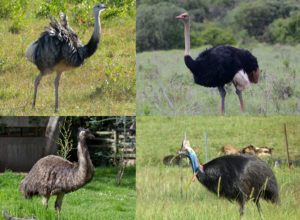Jul
12
Biogeography and the Cladistic Shake-n-Shuffle
“[I]t is far from true that biogeography unambiguously supports common ancestry.” — Dr. Günter Bechly
Biogeography is the study of the distribution of organisms across geographic space and geological time. It has been around for quite awhile but has gradually integrated concepts and information from several scientific disciplines, from evolutionary biology to climatology.

All “origins” positions need to take biogeography into consideration when formulating and refining a model. Interestingly, it seems to be the Young Earth Creationists and evolutionists who rely on it the most. The former need it — primarily in the form of floating logs and mats of vegetation, aka “rafting” — to explain post-Flood survival of plants and non-air-breathing land animals. The latter (including Charles Darwin himself) see it as an important line of evidence in support of common descent with modification.
However, there are many stubborn problems of biogeography and paleobiogeography that don’t comport with the evolutionary paradigm of common descent. One of them is the “disjunct distributions of organisms that do not occur in adjacent regions (or at least regions that are thought to have separated by continental drift).” Examples can be found among all types of creatures — lichen, molluscs, crustaceans, arachnids, insects, reptiles, birds, marsupials, primates, et al. But, the example I wanted to highlight here is that of ratite birds.
“Ratite birds? What are those?” I’m glad you asked.
Paleontologist Günter Bechly explains:
“These include very large flightless birds like the African ostriches, the extinct elephant birds from Madagascar, the South American rheas, the Australian emus, the cassowaries from Australasia, and kiwis and the extinct moas from New Zealand. Most biologists assumed that ratites are monophyletic and originated from a common flightless ancestor, and that their disjunct distribution is explained by the breakup of the ancient southern supercontinent Gondwana. Unfortunately, a few problems spoil this delightful just-so story:
1. Moas do not seem to be more closely related to the New Zealand kiwis (Cooper et al. 2001, Haddrath & Baker 2001).
2. Instead, the elephant birds of Madagascar are claimed to be the closest relatives of the New Zealand kiwis (Mitchell et al. 2014).
3. The breakup of Gondwana is much too long ago to explain the distribution of ratite birds by continental drift (vicariance biogeography), which cannot have originated before the Paleogene according to fossil and molecular clock evidence (Prum et al. 2015).

But wait, there is help from cladistics: Just shake the tree and reshuffle the taxa, so that all the ostrich-like birds could have evolved independently by multiple convergence from flying ancestors, and their biogeographic distribution could thus be due to normal aerial dispersal. This was suggested by the genomic study of Harshman et al. (2008), who found the flying tinamous to be nested within flightless ratite birds. This is, of course, contradicted by many morphological characters that unite all ratites, as well as by molecular data, and Harshman even mentions five recent studies that strongly supported ratite monophyly. These conflicting data were ignored in Harshman’s DNA study that was crafted by not fewer than 19 co-authors. Certainly the new molecular tree must be so robust that the new molecular evidence outweighs the conflicting evidence. Except that that is not the case: indeed Harshman et al. (2008) presented two very different trees, one in which tinamous are closer to rheas, and one in which they are closer to cassowaries, emus, and kiwis. But who cares? At least we got rid of an inconvenient biogeographical problem.
Unfortunately, there is more: In a study, Haddrath & Baker (2012) confirmed that tinamous nest within ratites, but now they are more closely related to the extinct moas, while rheas are closer to kiwis, cassowaries, and emus. Certainly, now we’ve got it right, at least till the next study with other genes, like that of Smith et al. (2013), who again got two different results for the position of tinamous like Harshman et al. (2008). Meanwhile a new study by Baker et al. (2014) vindicated the result of Haddrath & Baker (2012) (note that Scherz 2013 disputed all the alleged evidence for a position of tinamous within ratites). Isn’t phylogenetic tree reconstruction a wonderful science?”
Bechly provides other examples of problems with biogeography and the rafting hypothesis. Then he notes that not only have no “larger terrestrial animals [ever been] observed rafting in the middle of a large ocean”, but we have “substantial paleobiogeographical evidence that such dispersal by rafting simply did not happen in either direction even in cases of much smaller distances and long periods of time (Krause 2001, Clyde et al. 2003)”. He also quotes Casey Luskin, saying, “This kind of data may not necessarily absolutely falsify Darwinism, but at the least it challenges the simplistic argument that biogeography supports universal common descent through congruence between migration pathways and evolutionary history. In many cases, the congruence is simply not there” (Luskin 2015).
Finally, it is worth noting that “shak[ing] the tree and reshuffl[ing] the taxa” is not just something evolutionists must resort to (for whatever good it does them) in regards to biogeography issues. They do so in other cases when new discoveries throw a wrench into their presupposed evolutionary paradigm, too, such as with human origins.















